Solar Factories
As solar houses begin to be much more common, it is the emergence of solar powered factories that will be the real sign of a solar economy.
Here are few companies that are already dipping their toes in the water:
|
1. Ford at their Bridgend, Wales factory have installed $2.3m worth of solar panels. The panels are 'solar skylights' that not only contribute to the plant's power and lighting requirements, but also allow natural daylight to reach the workspace.
Covering 25,000 square metres of the plant's roof, 26 solar units (incorporating 1540 photovoltaic cells) have been installed. This 97 kW system provides all the lighting requirements for the building beneath.
|
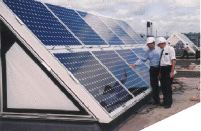 |
| 2. Interface Carpets sell a 'solar-made' carpet using Icelandic wool. The wool is washed in water straight from the hot geothermal springs nearby, the electricity to run the machines comes from natural hydroelectric schemes (lakes not dams) in the unpopulated centre of Iceland. Interface then weaves the wool into the high quality wilton 'Reykjavik' carpet using electricity from renwables at Firth Carpets in Yorkshire, England.
These pictures show another Interface company, Bentley Mills, in the City of Industry, California, which has one of the largest industrial solar installations in the U.S.
This huge, 100-kilowatt array of photovoltaic modules provides six percent of the power needs of the plant. This is enough energy to power one of the plantís 29 carpet tufting machines around the clock.
|
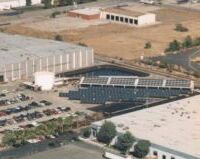
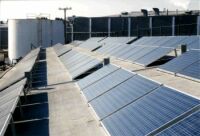
|
|
3.
Sony Chemical
Corporation introduced a solar power generation system on the
rooftop of its No. 3 Site in Kanuma. The systemís lifetime of over 30
years will help the site to secure a long-term
supply of clean energy. During
February 2000, its first month of full-scale
operation, it generated 7,120 kWh
of electric power, or 8% of the electric
power used in the plant.
|
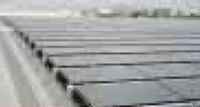
|
|
4.
Urtekram make a range of food, household and personal care products at their hay- and wind powered factory in Denmark. 100% of their electricity comes from their windmill, and 100% of their heat comes from burning hay.
|
 |
|
5. Patagonia, the California outdoor clothing manufacturer, were the first California company to buy all their electricity from newly constructed renewable energy plants, using almost a million kilowatt-hours annually.
They offset the additional cost of renewables by investing in energy conservation such as new lighting, insulation, new more efficient motors to drive the conveyor belts, and Patagonia has achieved a roughly 20% reduction on its electricity consumption. So although it will pay a small premium for using 100% renewable energy, its net costs will be less.
The picture shows the Patagonia Service Center in Reno, which has 88 solar tracking mirrors on the roof to reflect its light to the work floor below. It also has a PV installation.
|
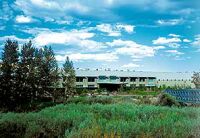 |
|
6.
Wilkhahn manufacture office furniture at their factory near Hannover in Germany. They have paid great attention to the ecological impact of design of their factory buildings, and one feature is this solar PV array on the south face.
|

|
|
7. Trannon also make furniture, using fast growing English ash from forests near to their Wiltshire factory. They need some heat to bend the wood into the desired shape, and this comes from a furnace that burns offcuts and sawdust -- a biofuel form of solar power.
|
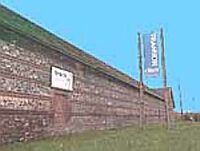
|
|
8. The Village Bakery in Cumbria uses organic ingredients and bakes bread using a state-of-the-art clean-burn wood furnace and a computer-controlled 4-rack walk-in oven. A sophisticated system of heat exchangers, flues and filters ensures that the maximum heat is extracted from the wood fire while minimising emissions to the atmosphere. The wood used is offcuts and sawdust from local wood processors -- an estimated 150 acres of woodland provides a sufficient supply in perpetuity.
|
 |
| 9. Ecover is the most famous ecological factory, but it has no solar electricity or heating to speak of. Belgium has not deregulated electricity supply, so there are no green electrons for Ecover to buy. Ecover consider the costs of installing a solar power station to be too high. Still, the factory does have a couple of photosynthetically-solar powered elements: The grass roof uses the transpiration of water as cooling for the building, and there are reed beds at the back to help with effluent processing.
|
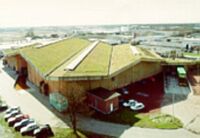 |
|
10.
Solar Farms?
Surprising as it may seem, most food and fibre is not "solar-grown". Agriculture is a big user of fossil energy, and as David Coley at Exeter University says, "we all eat oil", because 6 calories of fossil energy are used to make one calorie of food. This energy is used by tractors, fertilizer manufacture, food processing, chilling, storage and distribution.
A farm that used biodiesel or bioethanol tractors and only sold its produce locally would be significantly better than an identical farm selling to conventional channels. It's even possible to use pure rapeseed oil like this tractor converted by VEG-tuning in Sweden.
|
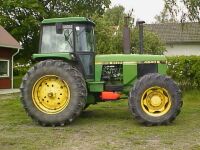 |
|
11.
Solarex made their PV factory solar powered, so creating a 'solar breeder'.
|
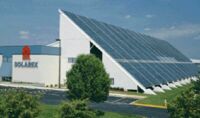 |
|
12.
Conclusion. In many ways it seems strange to invest so much time, money and roofspace in PV. After all, why build a power station? Even coal and gas fired power stations have a long (15 year) payback period. Yet these companies have obviously found it valuable, even if only in PR terms.
It seems to me that the canny ones are Firth Carpets and Patagonia, who buy 'green electrons' from local suppliers, so they can have their factories 100% solar powered with very little additional cost.
And while you can now buy products that are 'solar-made', I still think it's amazing that you can't get anything that's 'solar-grown'! Can someone please have a go, sooner rather than later?
|
|
|